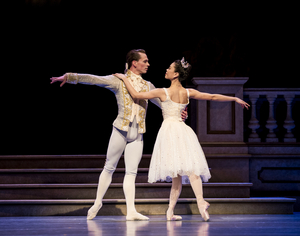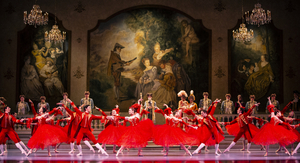Review: PACIFIC NORTHWEST BALLET'S CINDERELLA at McCaw Hall
PACIFIC NORTHWEST BALLET’s Sweetly Romantic and Visually Arresting Take on “Cinderella”


On the afternoon of February 2nd, 2020, a nearly sold-out audience for a performance of Pacific Northwest Ballet's "Cinderella" proved that diehard dancegoers and eager young ballet students will show up in full force even though plenty of other people decide to opt for watching Superbowl Sunday's football game. The audience in Seattle's McCaw Hall that day was rewarded with a superb performance of the ballet that was choreographed by Kent Stowell, who was PNB's Founding Artistic Director with his wife, Francia Russell, and premiered in 1994. Stowell and Russell passed the mantle to current Artistic Director, Peter Boal, in 2005. They are credited with staging the current production of "Cinderella".
Prior to curtain time, a free Ballet Talk by Doug Fullington, PNB Audience Education Manager and Assistant to Peter Boal, gave attendees a digestible yet thoroughly informative introduction to what was about to happen on stage. Fullington showed his considerable chops as a dance historian and musicologist on the consulting staff of PNB School. I applaud PNB for offering not only this enrichment opportunity but also a free Q&A following the performance with the delightfully approachable and witty Boal and with newly promoted Principal Dancer Kyle Davis, who had just made his role debut as Cinderella's Prince. I'm a relative newcomer to the Seattle area, having been transplanted only recently from NYC, and I am charmed by the ways in which PNB treats its audiences to in-depth dance knowledge as well as convivial respect. The Ballet Talk and Q&A session are two examples of that, but I am also pleased by the friendly tone of the pre-recorded admonitions to silence phones. For the "Nutcracker" in December, we heard the voices of two of the young Claras. For "Cinderella", we heard the voice of Laura Tisserand, the Fairy Godmother, asking us to make PNB's dream come true by not allowing phones to ring. Recalling the pre-performance announcements back at Lincoln Center, the NYC tone seems curt and impersonal compared to the friendlier West Coast versions I've heard.
As for the production itself, Stowell did indeed achieve his goal, stated in the program notes as that of recounting Cinderella's story with an emphasis "on the realization of a love relationship that restores a lost wholeness". Earlier versions of "Cinderella", based on Frederick Ashton's original and set solely to Prokofiev's score for "Cinderella", are rooted in the comic/tragic tradition of the English music hall. Stowell chose to interpolate other selections by Prokofiev, including "The Love of Three Oranges: Symphonic Suite" and a gavotte from Symphony No. 1 in D Major, to facilitate telling his tale. This ploy works very well. However, although I appreciate Stowell's version for the most part, I remain a steadfast fan of the marvelous travesty roles of men as the stepsisters in Ashton's version of "Cinderella". To me, Stowell's female stepsisters simply look like accomplished ballerinas trying to be clumsy. Not only that, but he has them dance right along with Cinderella in Act I, which erases any effect not only of their awkwardness but also of their animosity toward her.
On the plus side, though, I thoroughly enjoyed the scene in which Stowell's stepsisters are getting ready for the ball. Full disclosure: I may be a bit prejudiced here since the role of the Dancing Master was performed by corps de ballet member Ryan Cardea, who was my student as a child at Steps on Broadway in NYC.
In addition, I enjoyed the amazingly polished children from PNB School. In Act 1, the "Clock Children" (informally dubbed "the pumpkins" by the other dancers according to Doug Fullington during the pre-show talk) convincingly presaged the countdown to midnight that was to come in Act II. Kudos as well to the PNB Professional Division students performing right along with the company at various points. They did themselves proud.
After an intermission following Act 1, the curtains opened to reveal the ballroom scene for Act II with both the ladies and the gentlemen in brilliant red costumes. I had already seen photos of this moment, and I was skeptical about whether or not it would read well for me in the theater. It not only read well, it was glorious! I found myself applauding right along with the rest of the audience even before the dancers began to move. The red costumes by Martin Pakledinaz, which I had thought might be visual overload, were in fact absolutely perfect. That said, I was less enthralled by Cinderella's costumes. In Act 1, she didn't really seem to be wearing rags and in Act II, her white gown with a simple flowing fabric skirt failed to impress me in spite of its sparkles. Nevertheless, soloist Angelica Generosa in her debut as Cinderella was flawless and endearing. I predict she'll be promoted to principal soon. Partnered by the aforementioned and very accomplished Kyle Davis as the Prince, she danced with deceptive ease and gave affecting credence to the emotions of a young woman whose memories sustained her through difficulties that never succeeded in making her lose hope for the future of her dreams.
Even so, the dancer who stole the show was soloist Price Suddarth as the high-flying and fast-spinning Jester. Suddarth also displayed comedic flair, especially at one moment when he used ballet mime for a pretty face and then nixed it to let the Prince know that neither of the stepsisters was worthy of his affections.
Overall, I do prefer Stowell's "Cinderella" to the Ashton-based renditions I have seen. In particular, Stowell's clever device of a scrim halfway upstage that allows for current action to take place downstage even as dreams and recollections are enacted behind the scrim is masterful. Also fun is the moment when the Beggarwoman in Act I seems to disappear up the chimney only to reappear later as the Fairy Godmother. Then, In Act III after the Prince has seen that the lost shoe fits Cinderella, the upstage scenery and scrim fly up to reveal a dream world of blue sky with white clouds while the Fairy Godmother unites the young lovers. The role of Fairy Godmother was ably danced by Laura Tisserand who was also Cinderella's Dream Mother in Act I, a clear example of Stowell's gift for storytelling.
Given all of that on the positive side, I'll let it pass that the infamous glass slipper (a sparkly pointe shoe in this instance) isn't actually lost when Cinderella hurries toward the coach at midnight but rather has been planted behind a pillar before the act began. That's where the Jester finds it. The lost slipper, a key element in this classic story, should have been handled with much more finesse. Another less than fortuitous effect was that the clock image on a stage design of a proscenium was at 20 minutes to 12 right up until the minute hand finally began to move while the corps depicted the countdown to midnight during Prokofiev's compelling clock music. For me, glancing down at the dancers and up again at the clock made taking in the whole effect impossible. Then the clock stayed at midnight for the rest of the ballet even though days presumably passed. I'd scotch that clock altogether if I had my say in the matter!
My little quibbles notwithstanding, however, do see PNB's "Cinderella" if you can before this run ends on February 9th. I'm sure you won't be disappointed. And going forward, mark your calendars for the rest of the PNB current season with Alejandro Cerrudo's "One Thousand Pieces from March 13th to 22nd; "Beauty and the Beast" for young audiences on March 15th, 21st, and 22nd; "Giselle" from April 10th to 19th; and a triple bill of ballets by Edward Liang, Crystal Pite, and Twyla Tharp from May 29th to June 7th.
Photo credits: Pacific Northwest Ballet principal dancer Kyle Davis as the Prince with soloist Angelica Generosa as Cinderella in Kent Stowell's Cinderella. Photo © Elise Bakketun; Pacific Northwest Ballet company dancers in Kent Stowell's Cinderella. Photo © Angela Sterling.
Reader Reviews

Videos

